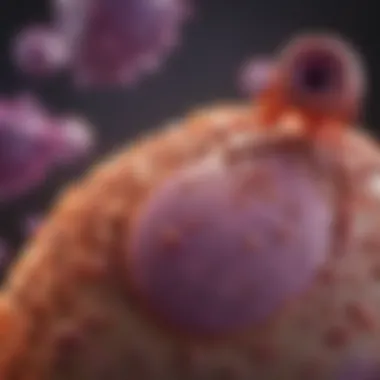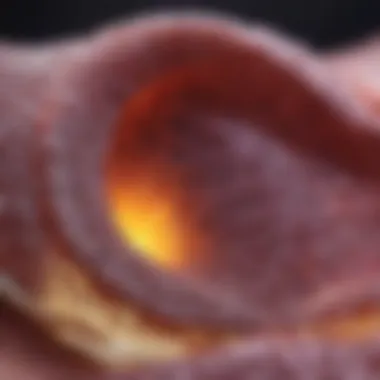Recognizing Early Signs of Pancreatic Cancer


Intro
Pancreatic cancer remains one of the most challenging malignancies to detect early. This difficulty arises from the absence of overt symptoms during the initial stages of the disease, often leading to a late diagnosis. Recognizing the early indicators becomes crucial because timely detection can significantly influence treatment options and patient outcomes.
Raising awareness about specific symptoms, along with understanding risk factors and advancements in diagnostic techniques, is essential for individuals, particularly those at higher risk. This section sets the stage for a deeper examination of how one can spot pancreatic cancer early.
Research Highlights
Overview of Key Findings
Recent studies reveal that pancreatic cancer symptoms may be subtle but can include non-specific warnings such as unexplained weight loss, persistent abdominal pain, and changes in appetite. Importantly, risk factors include family history, smoking, diabetes, and chronic pancreatitis. Furthermore, advancements in imaging technologies and biomarker research hold promise for improving early detection rates.
Significance of the Research
Understanding the significance of early detection cannot be overstated. Pancreatic cancer is often asymptomatic until it reaches an advanced stage. By highlighting key symptoms and risk factors, this article seeks to empower readers, educators, and healthcare professionals alike to foster a more proactive approach toward health monitoring. Recognizing the vital signs early can potentially lead to more successful interventions and improved prognoses for those affected.
"The ability to identify early signs of pancreatic cancer can significantly alter the trajectory of treatment and outcomes. Awareness is a key player in changing statistics."
Acknowledgments
Research in the field of pancreatic cancer detection continues to evolve. Collaborative efforts among scientists, medical professionals, and institutions play a crucial role in refining diagnostic approaches. Increasing public awareness through education and outreach initiatives will fortify these advancements in detection and treatment.
Understanding Pancreatic Cancer
Pancreatic cancer is a serious and often lethal disease that presents significant challenges in early detection and treatment. Understanding its complexities is vital for both individuals and healthcare professionals. This section aims to provide a foundation for recognizing how the disease develops, the population it affects, and the biological mechanisms involved.
Definition and Overview
Pancreatic cancer originates within the pancreas, an organ situated behind the stomach that plays a crucial role in digestion and blood sugar regulation. The disease is often classified into two major types: exocrine tumors, which account for the majority of cases, and neuroendocrine tumors, which are rarer. Exocrine tumors, particularly pancreatic adenocarcinoma, have a notorious reputation for rapid progression and late diagnosis, contributing to their high mortality rate.
The early subtlety of symptoms often leads to diagnosis at an advanced stage, making understanding and awareness critical. The pancreas's anatomical location makes it challenging for patients to recognize changes in health that might suggest cancer.
Epidemiology and Statistics
An estimated 60,000 new cases of pancreatic cancer are diagnosed each year in the United States, with the incidence rates increasing. The lifetime risk of developing the disease is around 1 in 64. The survival rate remains dismal, with approximately 10% of patients surviving five years post-diagnosis. Statistics reveal that the disease is more prevalent in older adults, particularly those over 65. Furthermore, certain demographic factors indicate that African Americans are more likely to develop the disease than Caucasian populations.
Data suggest a positive correlation between pancreatic cancer and lifestyle factors such as smoking, obesity, and diabetes. Additionally, genetics plays a crucial role, with families reporting a higher incidence of the disease. Recognizing these patterns can be instrumental in deriving effective early detection strategies.
Pathophysiology
The pathophysiology of pancreatic cancer involves a series of genetic mutations and changes that lead to malignancy. Multiple oncogenes and tumor suppressor genes have been implicated in its development. For instance, mutations in the KRAS gene are found in about 95% of pancreatic adenocarcinomas. Additionally, the tumor suppressor gene TP53 often harbors mutations, which lead to uncontrolled cellular proliferation.
As cancer progresses, the tumor microenvironment also undergoes significant alterations, including changes in extracellular matrix signaling and immune system interactions. These make therapy challenging as the tumor often becomes resistant to traditional treatments. The cellular behavior of pancreatic cancer is marked by invasion and metastasis at an early stage, highlighting the importance of early detection measures.
Understanding pancreatic cancer is essential for identifying risk factors and symptoms that can lead to timely diagnosis and improved patient outcomes.
Risk Factors Associated with Pancreatic Cancer
Understanding the risk factors associated with pancreatic cancer is essential in the early detection and prevention of this disease. Identifying these factors allows individuals to take proactive measures and engage in informed health monitoring. Pancreatic cancer often develops silently, and being aware of one's risk can lead to timely interventions.
Genetic Predispositions


Genetic predispositions play a significant role in the risk of developing pancreatic cancer.
- Familial Pancreatic Cancer: A family history significantly increases the likelihood of this condition. Individuals with first-degree relatives who have been diagnosed are at higher risk.
- Inherited Genetic Mutations: Certain inherited mutations, such as those in the BRCA1 and BRCA2 genes, are linked to an elevated risk.
- Other Syndromes: Conditions like Peutz-Jeghers syndrome and Lynch syndrome also contribute to the risk of pancreatic cancer.
By understanding these genetic factors, individuals might opt for genetic counseling, which can help them face their health choices more confidently.
Lifestyle Factors
Lifestyle factors are also crucial when considering pancreatic cancer risks. Several behaviors and habits have been identified that increase the likelihood of developing the disease. Important elements include:
- Smoking: Tobacco use is one of the most significant risk factors. Smokers are about twice as likely to develop pancreatic cancer compared to non-smokers.
- Diet: A diet high in red and processed meats, along with low consumption of fruits and vegetables, may elevate the risk.
- Obesity: Excess body weight contributes to increased inflammation and insulin levels, both of which might promote pancreatic cancer development.
- Physical Inactivity: A sedentary lifestyle is found to correlate with higher risks. Regular physical activity can help mitigate some of these risks.
Understanding these lifestyle choices allows individuals to assess their potential risk and make necessary changes for better health.
Medical History Considerations
Medical history can reveal essential information about the likelihood of pancreatic cancer.
- Chronic Pancreatitis: Long-term inflammation of the pancreas has been strongly linked to pancreatic cancer. Individuals with chronic pancreatitis should be vigilant about symptoms.
- Diabetes: New-onset diabetes, especially in people over 50 years, can indicate an increased risk for pancreatic cancer.
- Other Medical Conditions: Conditions like liver disease and certain stomach conditions may also play a role.
It is vital to note these factors in personal health assessments and discussions with healthcare professionals.
Recognizing and understanding risk factors can empower individuals to take charge of their health, potentially leading to early detection and better outcomes.
By being proactive about these risk factors, individuals can enhance their awareness of pancreatic cancer and act appropriately, ensuring better screening practices and health decisions.
Early Signs and Symptoms
Recognizing the early signs and symptoms of pancreatic cancer is pivotal for timely intervention and management. This type of cancer is notorious for its vague and non-specific manifestations, which can often be mistaken for other less severe conditions. Thus, understanding these signs is crucial for individuals, especially those at higher risk. The more familiar one becomes with these symptoms, the better they can act in seeking medical advice and arranging for necessary diagnostic tests. Early detection can significantly influence treatment options and can contribute positively to survival rates.
Unexplained Weight Loss
One of the most common signs of pancreatic cancer is unexplained weight loss. This weight loss typically occurs without any changes in diet or exercise. Individuals may notice that they are losing pounds rapidly, often without effort. This symptom can be particularly concerning and may signal an underlying condition. Weight loss can occur due to various factors associated with pancreatic cancer, including poor digestion and absorption of nutrients due to pancreatic malfunction. It is advisable for anyone experiencing this symptom to consult with a healthcare professional.
Abdominal Discomfort or Pain
Abdominal discomfort or pain is another significant symptom linked to pancreatic cancer. Patients may describe a dull ache in the abdomen that may linger or come and go. This discomfort can sometimes radiate to the back, leading to further complications in identifying the issue. It is important to note that many individuals may experience abdominal pain for a variety of reasons. However, if this pain seems unrelenting or unusual compared to prior experiences, it should raise concern. Recognizing the type of pain, along with its duration and associated symptoms, can provide healthcare providers with critical information.
Changes in Digestive Patterns
Alterations in digestive patterns can also signal pancreatic issues, including cancer. This can manifest as noticeable changes in bowel habits, such as diarrhea, oily stools, or constipation. The pancreas plays a vital role in digestion by producing enzymes that help break down food. If the pancreas is not functioning properly due to cancer, these enzymes may not be produced in sufficient amounts, leading to trouble digesting food properly. Therefore, monitoring any drastic changes in digestion is essential. Consulting a doctor is advisable if these symptoms arise alongside any other warning signs.
Jaundice and Its Implications
Jaundice is characterized by yellowing of the skin and eyes and can be an alarming indicator of pancreatic cancer. This occurs when bile ducts are obstructed by tumors or tumors located in the pancreas itself. Elevated bilirubin levels lead to this yellow discoloration, which can also cause dark urine and light-colored stools. Jaundice can indicate advanced disease, but it is essential to recognize that it can occur in various conditions. Therefore, it is critical to address this symptom promptly with a healthcare provider for accurate diagnosis and intervention.
Not all symptoms mean pancreatic cancer, but awareness can lead to early detection and better outcomes.
Diagnostic Methods for Early Detection
Detecting pancreatic cancer early significantly influences treatment outcomes and survival rates. Given the often subtle nature of symptoms, it's crucial for healthcare professionals and patients to have access to effective diagnostic methods. These methods aim to identify the disease in its initial stages when interventions can be more effective. The following subsections detail various diagnostic techniques, emphasizing their characteristics, benefits, and limitations.
Imaging Techniques


Imaging techniques are essential tools in the realm of early detection. They provide visual insights into the pancreas, helping identify any abnormalities that may suggest cancer.
CT Scans
CT Scans, or computed tomography scans, are highly regarded for their ability to capture detailed cross-sectional images of the body. This results in high-resolution images that can reveal tumors or cysts in the pancreas. One key characteristic of CT scans is their speed; they can often be completed in a short time frame, making them a practical choice in urgent assessments.
The unique feature of CT scans is their ability to use contrast dye. This dye enhances pictures of blood vessels and allows radiologists to better delineate pancreatic tumors from surrounding tissues. However, there are disadvantages; for instance, exposure to radiation is a concern, particularly in multiple scans. Overall, CT scans are beneficial in initial evaluations but should be weighed carefully against their risks.
MRI
Magnetic Resonance Imaging, or MRI, is another powerful imaging modality used in pancreatic cancer detection. One significant characteristic of MRI is its use of strong magnetic fields and radio waves, which means it does not expose patients to radiation. This makes it a safer option for regular monitoring, particularly for individuals at high risk of pancreatic cancer.
MRI’s unique advantage lies in its exceptional ability to differentiate between various soft tissue structures. This is crucial for accurately characterizing pancreatic lesions. However, MRI tends to take longer than CT and is sometimes less accessible. The combination of non-invasiveness and detailed imaging plays a vital role in early detection efforts.
Blood Tests
Blood tests mark a critical aspect of early detection for pancreatic cancer. They provide a non-invasive method to screen for potential indicators of the disease through biomarkers present in the bloodstream.
Tumor Markers
Tumor markers are substances found in the blood that can indicate the presence of cancer. In the context of pancreatic cancer, CA 19-9 is the most commonly investigated tumor marker. Its elevation can suggest pancreatic malignancies, although elevated levels can also occur in non-cancerous conditions. This duality is a crucial characteristic; while tumor markers can assist in diagnosis, they cannot definitively confirm cancer.
Furthermore, tumor markers are advantageous for monitoring treatment response and disease progression. However, their effectiveness as a standalone diagnostic tool is limited, making them best used in conjunction with imaging techniques for a comprehensive assessment.
Other Biomarkers
Beyond tumor markers, other biomarkers are under investigation for their potential to enhance early detection. These may include circulating cell-free DNA, which can offer indications of genetic alterations associated with cancer. One of the advantages of these biomarkers is their relative ease of testing; blood samples are minimally invasive and can be collected easily during routine health checks.
However, the specific markers and assays used can vary widely in sensitivity and specificity. More research is needed to validate their effectiveness in routine panreatic cancer screening, underscoring the need for caution in interpretation.
Endoscopic Procedures
Endoscopic procedures represent a more invasive approach to diagnosing pancreatic cancer. Techniques, such as endoscopic ultrasound, allow healthcare providers to visualize the pancreas directly and obtain tissue samples through fine-needle aspiration. This direct approach offers high sensitivity in identifying tumors that may not be visible through imaging alone. However, these procedures carry inherent risks, including infection or complications from anesthesia, which must be considered in the evaluation process.
In summary, early detection methods for pancreatic cancer encompass a variety of diagnostic approaches, each with distinct features and implications for patient outcomes.
Emphasizing the use of comprehensive evaluation strategies combines these modalities effectively, maximizing the potential for early intervention in pancreatic cancer management.
Importance of Early Screening
Early screening for pancreatic cancer holds significant value in improving patient outcomes. Pancreatic cancer is notorious for its late diagnosis due to vague symptoms that often mimic other conditions. This means patients may not receive treatment until the cancer has progressed to later stages, where options are more limited and less effective. The advantage of early detection lies not only in the possibility of surgical interventions but also in potential improvements to survival rates and quality of life.
Regular screenings can help uncover abnormalities before they develop into full-blown cancer. For those at high risk, such as individuals with genetic predispositions or a heavy smoking history, implementing a proactive screening regimen can lead to earlier diagnosis. This often results in better management and treatment outcomes.
- Early detection increases treatment options: Surgery, when feasible, remains the most effective treatment for localized pancreatic cancer. Early detection often means that the cancer has not spread, allowing for complete surgical resection.
- Reduced mortality rates: Studies indicate a marked decrease in mortality rates among patients diagnosed at earlier stages compared to those diagnosed later.
- Improved Post-treatment Quality of Life: Patients diagnosed early often experience less aggressive treatment approaches, which can lead to an enhanced quality of life.
"Catching pancreatic cancer early can mean the difference between life and death. It’s crucial to understand and act on the risk factors and symptoms."
Impact on Survival Rates
Data reveals a correlation between early detection and improved survival rates for pancreatic cancer. If diagnosed at stage I, the five-year survival rate can be as high as 39%. In contrast, if diagnosed at stage IV, that statistic plummets to around 3%. This stark contrast underlines why early screening is vital.


Key factors influencing survival rates include:
- Stage of Cancer at Diagnosis: Early-stage cancer typically has better outcomes due to the availability of more treatment options.
- Access to Healthcare: Patients with regular access to health services tend to have better survival statistics due to timely diagnosis.
Recommendations for High-Risk Groups
High-risk groups require tailored recommendations for screening. These groups include individuals with:
- Family History of Pancreatic Cancer: Those with multiple family members diagnosed should consider genetic counseling.
- Genetic Syndromes: Conditions like BRCA1, BRCA2, and Lynch syndrome can increase risk.
- Chronic Pancreatitis: Long-standing inflammation of the pancreas can elevate cancer risk.
For individuals in these categories, medical professionals may suggest:
- Starting screenings at an earlier age than the general population.
- Utilizing advanced imaging techniques or genetic testing.
- Regular consultations with specialists in gastroenterology or oncology to monitor changes in health status.
Overall, understanding the guidelines for high-risk groups is essential for proactive healthcare. Early and frequent screenings can catch changes before they escalate into a significant health concern.
Professional Guidelines and Recommendations
The professional guidelines and recommendations for pancreatic cancer screening are crucial for improving early detection of this often deadly disease. These guidelines are created by leading health organizations and provide a framework for healthcare providers. They aim to help identify individuals who are at risk and to enable timely intervention.
Adherence to these guidelines can lead to better patient outcomes. Early detection increases the chances of more effective treatment options. This consequently improves survival rates, a fact evidenced by numerous studies.
Screening Guidelines
Screening guidelines recommend specific protocols based on risk factors and personal health history. Several organizations, including the American Cancer Society, offer guidelines to help both practitioners and patients. These recommendations generally focus on the following:
- Risk Assessment: Identifying individuals with higher likelihood of developing pancreatic cancer based on family history and genetic predisposition.
- Imaging: For high-risk individuals, advanced imaging techniques such as MRI or endoscopic ultrasound may be suggested to detect early changes in the pancreas.
- Regular Monitoring: Implementing a schedule for periodic assessments can help catch potential tumors before they become invasive.
In addition to these guidelines, it's essential that individuals are aware of their personal health risks. Knowledge can empower them to seek prompt evaluation from healthcare professionals.
Role of Healthcare Providers
Healthcare providers play a pivotal role in the identification and management of pancreatic cancer risk. Their responsibilities encompass:
- Educating Patients: Providers should inform patients about the importance of screening, especially if they fall into high-risk groups.
- Conducting Thorough Assessments: A comprehensive review of symptoms and health history must be undertaken to determine the need for further testing.
- Staying Updated with Research: Continuous education on advances in screening techniques and treatments will enable healthcare providers to offer the most current recommendations to patients.
"Being proactive in conversations about health and screenings can save lives. Early diagnosis is key."
Navigating Concerns and Next Steps
Navigating the maze of health concerns, especially those surrounding pancreatic cancer, can be daunting. The importance of this section lies in empowering individuals with knowledge that may aid in early detection and proactive health management. Awareness of pancreatic cancer's subtle manifestations can markedly influence outcomes, enhancing the chance of intervention before the disease progresses. By addressing personal health assessments and appropriate discussions with healthcare professionals, individuals can take decisive steps in their health journey, allowing for informed decisions when faced with potential symptoms.
Personal Health Assessments
Conducting personal health assessments is a fundamental aspect of early cancer detection. This involves a thorough understanding of one's health history, lifestyle choices, and any changes in the body. Here are key steps for effective assessments:
- Review Health History: Examine your medical history and that of your family. Noting any occurrences of pancreatic cancer or genetic predispositions is crucial.
- Monitor Symptoms: Keep a log of any unusual symptoms. Even subtle changes, such as unexplained weight loss or abdominal discomfort, should not be dismissed.
- Evaluate Lifestyle Choices: Diet, physical activity, and smoking status can significantly impact overall health. Regularly assess these factors as part of your wellness strategy.
- Regular Screenings: Engage in regular health check-ups. Schedule blood tests and imaging scans as advised by your healthcare provider, especially if you are at heightened risk.
"Early detection is key. Regular self-assessments could be the difference between successful intervention and advanced disease status."
By actively engaging in personal health assessments, individuals can stay vigilant. Recognizing potential signs early on is vital in facilitating timely medical support.
Discussing Symptoms with Medical Professionals
Open communication with medical professionals is critical after identifying potential symptoms. This dialog can facilitate early diagnosis and treatment. Here are suggestions for a productive discussion:
- Be Honest and Detailed: When describing symptoms, provide as much detail as possible. Talk about duration, frequency, and intensity of any discomfort you may be experiencing.
- Inquire About Tests: If you suspect pancreatic cancer, discuss available diagnostic tests such as CT scans or blood tests. Ask about the relevance of these procedures in your case.
- Express Concerns: Don't hesitate to voice any fears or concerns. Medical professionals value informed patients and can address critical points that may affect your well-being.
- Follow Up: After initial discussions, ensure to follow up with your healthcare provider. Ask for clarification on any prescribed treatment or next steps. Consistency in dialogue is crucial for confidence in your care pathway.
Navigating concerns around pancreatic cancer requires a proactive approach. By conducting personal health assessments and maintaining an open line of communication with medical professionals, individuals enhance their chance of early detection and better outcomes.







